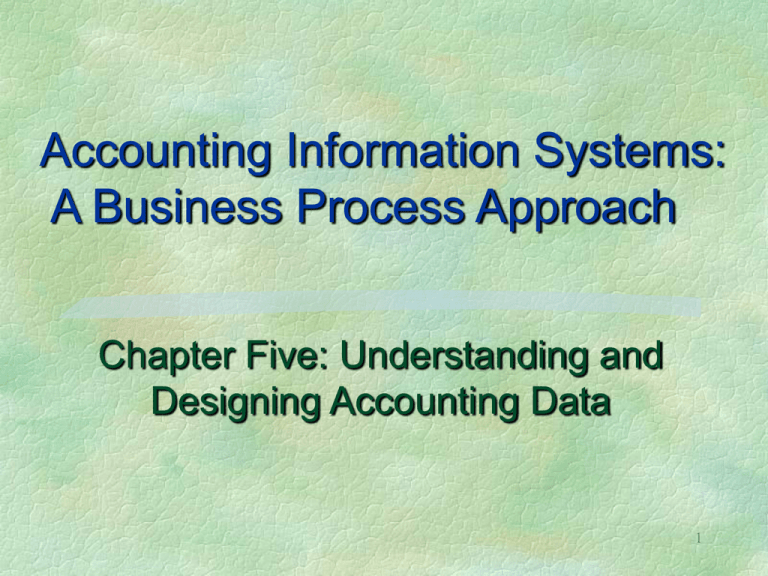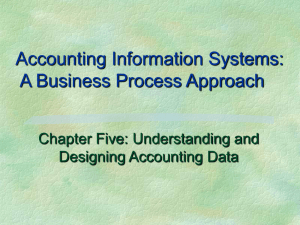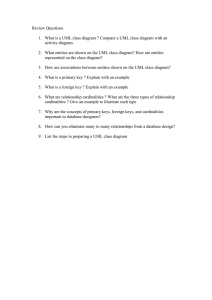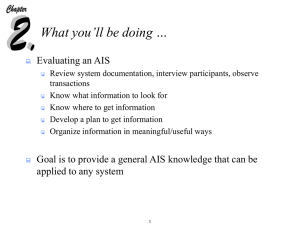Accounting Information Systems: A Business Process Approach Chapter Five: Understanding and
advertisement

Accounting Information Systems: A Business Process Approach Chapter Five: Understanding and Designing Accounting Data 1 Learning Objective After completing this chapter, you should understand: Attributes, primary keys, and foreign keys Relationship cardinalities (one-to-one, oneto-many, and many-to-many) 2 Learning Objective (Continue) After completing this chapter, you should able to: Identify transaction and master tables in an AIS database Assign keys to relate tables for use an application Identify relationship cardinalities in a business process Use event analysis to design tables and attributes for a database, and use a UML class diagram to document your design. 3 Exhibits: 5.2, 5.4 Tables: 5.1, 5.2 4 Exhibit 5.2 Outline of Steps in Developing a UML Class Diagram Four basic steps need to be taken to create a UML class diagram. Step 1: Place the required transaction tables (files) on the UML class diagram. Accomplish this step by doing the following: Identify events in a business process. Use the procedures described in Chapter 2. Decide which events will need transaction tables. Exclude events that do not need to be recorded in the computer system and exclude query, reporting, and maintenance events. Start the UML class diagram by showing a box for each event requiring transaction tables. In each box, place a name for the event. Arrange the boxes, one below the other, in the sequence in which the events normally occur. Step 2: Place the required master tables (files) on the UML class diagram. Accomplish this step by doing the following: For each event on the UML class diagram (from Step 1), determine the related goods, services, or agent entities. Determine which of the identified entities require master tables. Consider using master tables to track the location of cash and the effect of events on account balances in the general ledger. Add the required master tables to the appropriate side of the UML class diagram. Draw lines connecting the master tables to the related transaction 5 tables. Exhibit 5.2 Outline of Steps in Developing a UML Class Diagram (Concluded) Step 3: Determine the required relationship between the tables by doing the following: For each of the connecting lines, determine the cardinality of the relationship between the tables. Your cardinalities should be (1,1), (1,m), (m,1), or (m,m). Write the cardinalities next to the line between the entities. If there are any many-to-many relationships, convert them to one-to-many relationships by adding a junction table. The junction table must include the primary keys of each of the tables in the many-to-many relationship. Step 4: Determine the required attributes by doing the following: Assign a primary key to each of the tables. Write the primary key in the box for that entity/table. Link related tables by adding a foreign key to one of the pair in the relationship. Write the foreign keys in the entity boxes, as appropriate. Assign other attributes as needed for providing information content. There will probably not be enough space to enter these attributes in the boxes. Instead, prepare a table that shows the informational attributes for each entity. 6 Exhibit 5.4 Revenue Cycle for H & J Tax Preparation Service H & J Tax Preparation Service offers a variety of tax services. Information about its services is provided in the following Tax Services Report: Tax Services Report Service# Service Description 1040 Sch-A Sch-B Sch-C State Corp Federal Individual Income Tax Form 1040 $120,000 (long form) 1040 Schedule A (itemized deductions) 1040 Schedule B (interest & dividend earnings) 1040 Schedule C (Sole proprietorship) State Income Tax Return Corporate Income Tax Year-to-Date Revenues Fee $100 50 50 110 80 30 (per hr.) 51,000 53,300 84,000 81,000 103,000 7 Exhibit 5.4 Revenue Cycle for H & J Tax Preparation Service (Continued) The company is interested in developing an automated system for recording services rendered and billing clients. Except for the tax software used to prepare the tax return, the current system is manual. The revenue cycle of H & J Tax Preparation Service, up to the point of collection, is described as follows. A client calls the office to inquire about tax services. The secretary sets an appointment for the client to meet with an accountant. The client meets with an accountant and decides on the tax services that will be needed. The accountant then prepares a Service Request Form indicating the agreed-upon services. An example is shown here: Service Request Form Request# 104 Client: Robert Barton Service# Service Description 1040 Sch-A Sch-B State Accountant: Jane Smith Date: 2/10/2003 Fee Federal Individual Income Tax Form 1040 (long form) 1040 Schedule A (itemized deductions) 50 1040 Schedule B (interest & dividend earnings) 50 State Income Tax Return 80 Total $280 $100 8 Exhibit 5.4 Revenue Cycle for H & J Tax Preparation Service (Concluded) The client gives a copy of the Service Request Form to the secretary. For new clients, the secretary takes the client information (e.g. client name, address, contact person, and telephone no.) from the client and records it on a Client Form. She files the client form along with a copy of the Service Request Form in a client folder. A part of the client form is shown here: Client Form Client#: 1001 Client: Robert Barton Address: 242 Greene St. St. Louis, MO 63108 Telephone#: 431-555-4530 The accountant obtains information necessary for preparing the returns from the client (e.g., income and deductions). The information is entered into Mega-Tax, a tax software product used at the company. The recording and storage of tax information is handled by the Mega-Tax software and is separate from the rest of the revenue cycle. The company is not planning to integrate the tax preparation software with the rest of the revenue cycle. Thus, in this case, you can disregard the recording, updating, and processing of detailed tax return information. When the tax return is finished, the accountant gives the tax return to the secretary. She writes the services provided and the charges for each on an invoice, with the total amount due shown at the bottom. She then notifies the client that the return is ready. 9 Table 5.1 Events and Transaction files for ELERBE, Inc. Actual design No Event Transaction file(s) needed? Respond to Possibly, if salespeople wish to track a customer’s communications customer inquiries with the company in order to understand customer preferences. Take order Yes. A file is needed to record details so that the order can be filled. Pick goods Probably not. The actual quantities picked can be recorded in a file during the next event. Ship goods Yes. A file is needed to record quantities shipped so that inventory balances can be updated. Bill customer Yes. A file is needed to record invoice number, payment Yes terms, and amount owed so that (1) sales reports can be printed, (2) the customer’s balance due can be updated, and (3) data are available for processing the payment when received. Receive and record Yes. A file is needed to record payments so that they can be applied Yes cash receipts against invoices and so that customer balances and cash balances can be updated. Deposit checks Possibly. A file can be created for comparison to the deposits No reported on the bank statement, although merely keeping deposit receipts might serve this purpose. 10 Table 5.2A Tables Used in ELERBE’s Order Processing Application Panel A: Customer Table Contact Customer# 3450 3451 3452 Name Brownsville C.C. Educate, Inc. Bunker Hill C.C. Address Brownsville,TX Smith Fairhaven, MA Costa Bunker Hill, MA LaFrank _Person Telephone# 956-555-0531 508-888-4531 617-888-8510 Panel B: Inventory Table ISBN 0-256-12596-7 0-127-35124-8 0-135-22456-7 0-146-18976-4 0-145-21687-7 0-235-62415-6 Author Barnes Cromwell Cromwell Quantity_ Quantity_ On_Hand Allocated 4,000 300 $65.00 3,500 0 5,000 50 Title Price Introduction to Business $78.35 Building Database Applications Management Information $68.00 Systems Johnson Principles of Accounting $70.00 8,000 Platt Introduction to E-commerce $72.00 5,000 Rosenberg HTML and Javascript Primer $45.00 260 40 6,000 11 0 Table 5.2A Tables Used in ELERBE’s Order Processing Application (Concluded) Panel C: Order Table Order# Order_Date 0100011 05/11/2003 0100012 05/15/2003 0100013 05/16/2003 Customer# 3451 3451 3450 Panel D: Order_Detail Table Order# ISBN 0100011 0-256-12596-7 0100011 0-146-18976-4 0100012 0-135-22456-7 0100012 0-146-18976-4 Quantity 200 200 50 50 0100012 40 0-145-21687-7 12 Table 5.2B Inventory ISBN Author Etc. 0-256-12596-7 0-135-22456-7 0-146-18976-4 0-145-21687-7 Barnes Cromwell Johnson Platt .... .... .... .... Order Order# Order_Date Customer# 0100011 0100012 05/11/2003 05/15/2003 3451 3451 Order Detail Order# ISBN Quantity 0100011 0100011 0100012 0100012 0-256-12596-7 0-146-18976-4 0-135-22456-7 0-146-18976-4 200 200 50 50 0100012 0-145-21687-7 40 13




